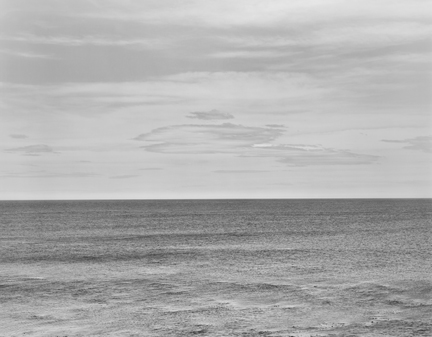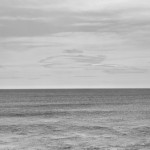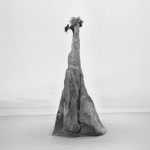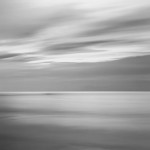By SCOTT ALBERG
Chip Hooper’s ten silver prints, from the series New Zealand’s South Pacific and Tasman Sea, exhibited at the Robert Klein Gallery, are on first glance evocative of the hackneyed sublime one has come to expect from traditional black and white photographs of beaches and oceans. Adroitly printed and artful in their use of tonality and contrast, Hooper’s photographs capture the momentary play of light on the waves, the unyielding expansiveness of the ocean, and the stoicism of rock formations on the frontline of the Tasman’s cyclical advances onto the shore. Though appearing to be platitudes, these images in fact yield more than the trite and the expected. In Hooper’s images one observes a tension between the fetish of the large format camera’s ability to inform and focus detail, and the mechanism’s inherent proclivity toward recording duration. For what is the common motif in these images of Hooper’s is a characteristic blur most certainly caused by long exposure times. Hooper has embedded in his images a layering of consecutive moments which in turn read as a stratigraphy of the perpetual, bringing his images in opposition to the timelessness or stasis most viewers expect from their black and white landscape photography.
In “Moonlight, Tasman Sea”, 2004, Hooper gives us an image completely blurred during the long exposure by the movements of the clouds and the lapping of the waves. The image is composed so that the lower third of the image is water, and the top two thirds are sky and clouds. With no land in sight, the image verges on abstraction. Are we at sea, surrounded by the equivalence of the ocean, or are we on land, surveying the horizon? It is with views such as this that Hooper is able to break from the inclusive, descriptive, and almost God-like eye of Ansel Adams’ most famous landscapes, instead depicting viewpoints that are more human in scale and ambition. In “Moonlight”, we recognize the compositional limits of the frame, the fact that more ocean and sky exist outside of our vision. Most importantly, we intuit in the movements of sea and clouds an actual space where at least the photographer once stood, surrounded by the elements depicted in the photograph. Like Hiroshi Sugimoto, Hooper’s camera becomes something in between a still and a movie camera, inclined more toward recording than straight image making.
In “Giant’s Tooth, Tasman Sea”, 2003, a bird’s nest is found on top of a geological formation blowing in the breeze. The sea is blurred, and the sky is washed out by overexposure. Hooper, bringing it into sharp contrast with the undifferentiated sand, sea and sky, focuses on the formation’s texture, abraded and worn over the millennia. In relief from its surrounds, the formation’s presence is monumental. And yet engulfed by duration, it too will succumb to time’s advance.
The images displayed at Robert Klein are very good despite their subject matter’s ubiquity within photographic portfolios, computer screen “wallpaper,” and popular expectations of what photography should be. What prevents these photographs from becoming calendar fodder is Hooper’s sensitivity and discretion toward keeping his imagery small, for what he is truly interested in is not the enormity of Nature, or the infinity of Time, but the passing of but only a very few, specific moments. And these moments are not really anything special. They are generic. Over the annals of time they occur again and again and again, and will continue to. Hooper understands that photography can give form or shape to these moments. His inclination is rightly not to freeze them, but to describe them.
- Chip Hooper, From Shag Point, South Pacific, 2003.
- Chip Hooper, Giants Tooth, Tasman Sea, 2003.
- Chip Hooper, Moonlight, Tasman Sea, 2004.
"Chip Hooper: New Zealand's South Pacific and Tasman Sea" is on view November 30 - February 9, 2008 at Robert Klein Gallery.
All images are courtesy of the artist and Robert Klein Gallery.







